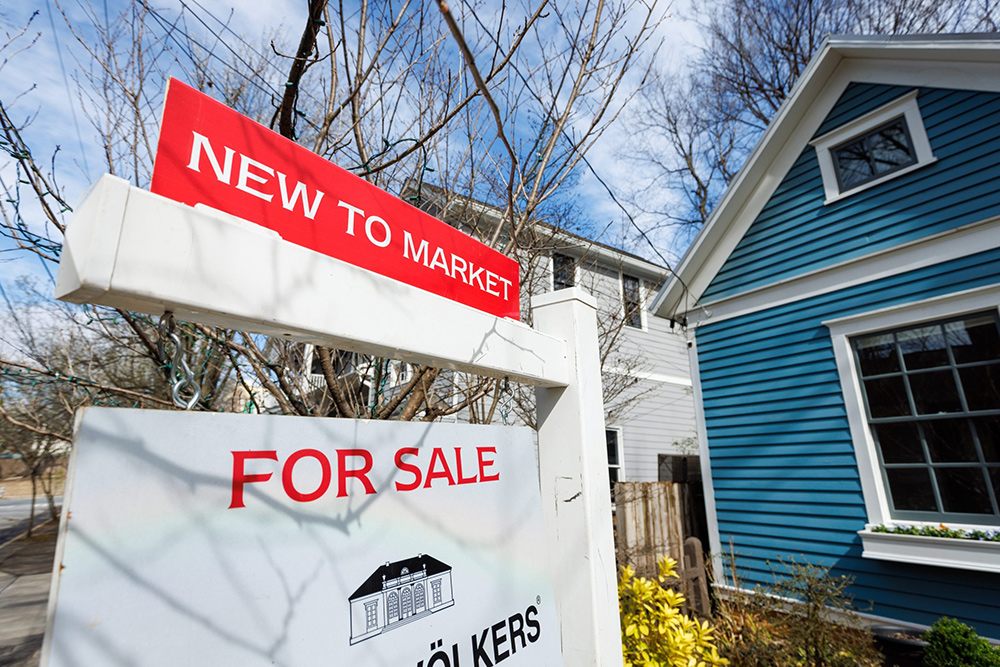
一家大型评级机构表示,美国不仅房租高得离谱,房价同样过高。但今年的经济形势意味着这种情况短期内不太可能发生改变。
惠誉评级(Fitch Ratings)周三发布的一份最新报告显示,今年第二季度,全美房产的价值被“高估”9.4%,这意味着房价不符合房子的实际价值。该评级机构表示,由于房价仍在上涨,因此未来几个季度,其“预测房产价值被高估的情况依旧会存在”。
据凯斯-席勒全美房价指数(Case-Shiller U.S. National Home Price Index)显示,虽然今年平均30年期固定抵押贷款利率曾短暂突破8%,但美国的房价从1月到9月暴涨了6.7%。美国房地产经纪人协会(National Association of Realtors,NAR)的数据显示,11月,各类住宅的中位数现房价格连续五个月上涨,同比上涨4%,达到387,600美元。
美国房地产经纪人协会首席经济学家劳伦斯·云在一份报告中表示:“房价仍在持续走高。”他认为“只有房屋供应量大幅增加才能抑制房价上涨”。
惠誉评级还预测,明年全美房价将上涨3%,2025年将再度上涨2%至4%。该评级机构在周三的报告中写道:“这会继续影响房产的可负担性,尤其是初入房地产市场的首次购房人将受到影响,进而抑制需求。”
惠誉发现,第二季度,在房价上涨和高抵押贷款利率的双重影响下,美国88%的大都市统计区(MSA)房屋价值被高估。超过一半大都市统计区的房屋价值被高估10%甚至更高。前三名分别是哪些地区?它们并不是纽约或洛杉矶这些大城市,而是南卡罗来纳州查尔斯顿、德克萨斯州厄尔巴索和新泽西州坎登。
对购房人不利的未来前景
过去几年,美国房价持续上涨和抵押贷款利率升高,破坏了房产的可负担性。美国房地产经纪人协会调查发现,10月,美国人的平均月供同比增加了10.6%,达到2,259美元。相比之下,中位数家庭收入同期涨幅只有2.1%。
目前抵押贷款利率依旧高于6.5%,相比之下2022年1月的抵押贷款利率仅为3%,因此美国房地产经纪人协会的房屋可负担性指数下降至只有91.4。这绝非好消息,因为凡是该指数低于100,都意味着美国普通家庭买不起一套中位数价格的房子。
房屋可负担性持续下降的原因不难理解。正如惠誉在周三的报告中所解释的那样,“持续高抵押贷款利率的环境和房价高企带来的巨大压力”,以及现房“供应不景气”,导致房地产市场变得可望而不可及。
美国持续多年面临严重的房屋供应短缺问题,有专家估计市场缺口在210万套至600万套之间。联信银行(Comerica Bank)首席经济学家比尔·亚当斯在周二表示:“美国房地产经纪人协会的房屋可负担性指数显示,大多数美国人买不起一套普通住宅,而少数买得起房的美国人,在现房市场的选择少得可怜。”
然而,最近几个月,房屋建筑商传出了一些令人鼓舞的好消息。凯投宏观(Capital Economics)房地产经济学家托马斯·瑞恩在周二解释称:“11月,市场上的现房库存严重不足,继续支持新房建设需求和施工活动。”美国新房开工总量从10月到11月增加了14.8%,达到156万套,创下5月以来的最高水平。
美国房屋建筑商协会(NAHB)主席艾丽西亚·休伊在一份探讨建筑业繁荣的报告中表示:“面对全国性的严重房屋供应不足,刺激新房建设是缓解可负担性危机、扩大房屋库存和降低通胀的最佳途径。”休伊是一位来自阿拉巴马州伯明翰的定制房屋建筑商和开发商。
然而,凯投宏观的瑞恩警告称,即使“明年抵押贷款利率继续下降”,他依旧预测现房库存会“极其紧张”。杰富瑞集团(Jefferies)的高级经济学家托马斯·西蒙斯本周在一篇报告中警告,虽然最近房屋建筑商的数据“确实令人鼓舞,也表明市场上长期严重供应不足的情况即将得到一些缓解,但对于这种强度能否持久,我们持怀疑态度。”
房地产交易公司Bright MLS的首席经济学家丽萨·斯特蒂文特此前对《财富》杂志表示,总体而言,房屋可负担性的前景依旧堪忧。
她说道:“新房建设量依旧无法满足需求。在建新房不足导致房租和房价上涨,使得个人和家庭很难找到他们能买得起的房子。”(财富中文网)
翻译:刘进龙
审校:汪皓
2023年2月17日星期五,美国乔治亚州亚特兰大市,一栋住宅外的“待售”标志。摄影:DUSTIN CHAMBERS/彭博社经盖蒂图片社提供
一家大型评级机构表示,美国不仅房租高得离谱,房价同样过高。但今年的经济形势意味着这种情况短期内不太可能发生改变。
惠誉评级(Fitch Ratings)周三发布的一份最新报告显示,今年第二季度,全美房产的价值被“高估”9.4%,这意味着房价不符合房子的实际价值。该评级机构表示,由于房价仍在上涨,因此未来几个季度,其“预测房产价值被高估的情况依旧会存在”。
据凯斯-席勒全美房价指数(Case-Shiller U.S. National Home Price Index)显示,虽然今年平均30年期固定抵押贷款利率曾短暂突破8%,但美国的房价从1月到9月暴涨了6.7%。美国房地产经纪人协会(National Association of Realtors,NAR)的数据显示,11月,各类住宅的中位数现房价格连续五个月上涨,同比上涨4%,达到387,600美元。
美国房地产经纪人协会首席经济学家劳伦斯·云在一份报告中表示:“房价仍在持续走高。”他认为“只有房屋供应量大幅增加才能抑制房价上涨”。
惠誉评级还预测,明年全美房价将上涨3%,2025年将再度上涨2%至4%。该评级机构在周三的报告中写道:“这会继续影响房产的可负担性,尤其是初入房地产市场的首次购房人将受到影响,进而抑制需求。”
惠誉发现,第二季度,在房价上涨和高抵押贷款利率的双重影响下,美国88%的大都市统计区(MSA)房屋价值被高估。超过一半大都市统计区的房屋价值被高估10%甚至更高。前三名分别是哪些地区?它们并不是纽约或洛杉矶这些大城市,而是南卡罗来纳州查尔斯顿、德克萨斯州厄尔巴索和新泽西州坎登。
对购房人不利的未来前景
过去几年,美国房价持续上涨和抵押贷款利率升高,破坏了房产的可负担性。美国房地产经纪人协会调查发现,10月,美国人的平均月供同比增加了10.6%,达到2,259美元。相比之下,中位数家庭收入同期涨幅只有2.1%。
目前抵押贷款利率依旧高于6.5%,相比之下2022年1月的抵押贷款利率仅为3%,因此美国房地产经纪人协会的房屋可负担性指数下降至只有91.4。这绝非好消息,因为凡是该指数低于100,都意味着美国普通家庭买不起一套中位数价格的房子。
房屋可负担性持续下降的原因不难理解。正如惠誉在周三的报告中所解释的那样,“持续高抵押贷款利率的环境和房价高企带来的巨大压力”,以及现房“供应不景气”,导致房地产市场变得可望而不可及。
美国持续多年面临严重的房屋供应短缺问题,有专家估计市场缺口在210万套至600万套之间。联信银行(Comerica Bank)首席经济学家比尔·亚当斯在周二表示:“美国房地产经纪人协会的房屋可负担性指数显示,大多数美国人买不起一套普通住宅,而少数买得起房的美国人,在现房市场的选择少得可怜。”
然而,最近几个月,房屋建筑商传出了一些令人鼓舞的好消息。凯投宏观(Capital Economics)房地产经济学家托马斯·瑞恩在周二解释称:“11月,市场上的现房库存严重不足,继续支持新房建设需求和施工活动。”美国新房开工总量从10月到11月增加了14.8%,达到156万套,创下5月以来的最高水平。
美国房屋建筑商协会(NAHB)主席艾丽西亚·休伊在一份探讨建筑业繁荣的报告中表示:“面对全国性的严重房屋供应不足,刺激新房建设是缓解可负担性危机、扩大房屋库存和降低通胀的最佳途径。”休伊是一位来自阿拉巴马州伯明翰的定制房屋建筑商和开发商。
然而,凯投宏观的瑞恩警告称,即使“明年抵押贷款利率继续下降”,他依旧预测现房库存会“极其紧张”。杰富瑞集团(Jefferies)的高级经济学家托马斯·西蒙斯本周在一篇报告中警告,虽然最近房屋建筑商的数据“确实令人鼓舞,也表明市场上长期严重供应不足的情况即将得到一些缓解,但对于这种强度能否持久,我们持怀疑态度。”
房地产交易公司Bright MLS的首席经济学家丽萨·斯特蒂文特此前对《财富》杂志表示,总体而言,房屋可负担性的前景依旧堪忧。
她说道:“新房建设量依旧无法满足需求。在建新房不足导致房租和房价上涨,使得个人和家庭很难找到他们能买得起的房子。”(财富中文网)
翻译:刘进龙
审校:汪皓
It’s not just the rent that’s too damn high—so are home prices, according to a major ratings agency. But the economic landscape this year means that’s unlikely to change soon.
National home prices were 9.4% “overvalued”—meaning their price does not align with the property’s actual value—in the second quarter of this year, according to a new Fitch Ratings report released Wednesday. And with prices still rising, the ratings agency said it “expects overvaluation to remain” in the coming quarters.
Even as the average 30-year fixed mortgage rate briefly topped 8% this year, U.S. home prices surged 6.7% between January and September, according to the Case-Shiller U.S. National Home Price Index. And data from the National Association of Realtors (NAR) shows median existing-home price for all types of housing jumped for the fifth consecutive month in November, rising 4% from a year ago to $387,600.
“Home prices keep marching higher,” NAR’s chief economist Lawrence Yun said in a statement, arguing that “only a dramatic rise in supply will dampen price appreciation.”
Fitch Ratings also expects national home prices to rise as much as 3% next year, and another 2% to 4% in 2025. “This will continue to impact affordability, particularly for entry-level and first-time homebuyers, thereby constraining demand,” the ratings agency wrote in its Wednesday report.
Fitch found that price increases and high mortgage rates left U.S. homes overvalued in 88% of the country’s metropolitan statistical areas (MSAs) in the second quarter. And more than half of these MSAs were overvalued by 10% or more. The top three? They’re not major cities like New York City or Los Angeles, but Charleston, South Carolina; El Paso, Texas; and Camden, New Jersey.
A difficult outlook for homebuyers
Rising U.S. home prices and higher mortgage rates have combined to destroy home affordability over the past few years. In October, Americans’ average monthly mortgage payment climbed 10.6% from a year ago to $2,259, according to NAR. That’s compared to a mere 2.1% rise in the median household income over the same period.
And with mortgage rates still above 6.5%, compared to just 3% in January 2022, NAR’s Housing Affordability Index has fallen to just 91.4. That’s not great news considering any level below 100 means the average U.S. family cannot afford a median-priced home.
There’s no mystery as to why home affordability keeps declining. As Fitch explained Wednesday, the “persistently high mortgage rate environment and the sustained pressure of elevated home prices,” coupled with a “stagnant supply” of existing homes, has made for an out-of-reach housing market.
The U.S. has faced a serious housing shortage for years, with experts estimating the market needs between 2.1 million and 6 million additional units. “Most Americans can’t afford the typical house, according to the National Association of Realtors’ Affordability Index—but the minority who can face slim pickings in the existing home market,” Bill Adams, chief economist for Comerica Bank, said Tuesday.
However, there has been some encouraging news from homebuilders in recent months. “The extreme lack of existing inventory on the market continued to support newbuild demand and construction activity in November,” Thomas Ryan, a property economist at Capital Economics, explained Tuesday. Total U.S. housing starts rose 14.8% from October to November, to 1.56 million units, their highest level since May.
“With the nation facing a considerable housing shortage, boosting new home production is the best way to ease the affordability crisis, expand housing inventory and lower inflation,” NAHB chairman Alicia Huey, a custom home builder and developer from Birmingham, Alabama, said in a statement discussing the building boom.
However, Capital Economics’ Ryan warned that he still expects existing inventory to remain “extremely tight” even if “mortgage rates continue to fall next year.” And Jefferies’ senior economist Thomas Simons cautioned in a note this week that although the recent data from homebuilders is “certainly encouraging, and suggest that a critically, chronically under-supplied market is about to find some relief, we are skeptical that we will see this strength persist.”
Overall, the outlook for housing affordability remains shoddy at best, as Lisa Sturtevant, chief economist with the real estate listing service company Bright MLS, previously told Fortune.
“We are still not building enough new housing to keep up with demand. A lack of sufficient new housing construction drives rents and home prices up, making it difficult for individuals and families to find housing they can afford,” she said.






